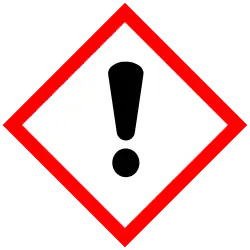3,4-Dichloro-1,2,5-thiadiazole
 | |
| Identifiers | |
|---|---|
3D model (JSmol)
|
|
| ChemSpider | |
| ECHA InfoCard | 100.024.757 |
| EC Number |
|
PubChem CID
|
|
| UNII | |
CompTox Dashboard (EPA)
|
|
| |
| |
| Properties | |
| C2Cl2N2S | |
| Molar mass | 155.00 g·mol−1 |
| Density | 1.648 g/cm3 |
| Boiling point | 158 °C (316 °F; 431 K) |
| Hazards | |
| GHS labelling:[1] | |
 
| |
| Danger | |
| H301, H315, H319, H335, H412 | |
| P261, P264, P264+P265, P270, P271, P273, P280, P301+P316, P302+P352, P304+P340, P305+P351+P338, P319, P321, P330, P332+P317, P337+P317, P362+P364, P403+P233, P405, P501 | |
Except where otherwise noted, data are given for materials in their standard state (at 25 °C [77 °F], 100 kPa).
Infobox references
| |
3,4-Dichloro-1,2,5-thiadiazole is the heterocycle with the formula Cl2C2N2S. It is a colorless liquid. The compound is produced by treating cyanogen with disulfur dichloride.[1] The compound can also be prepared from aminoacetonitrile.[2]
It is a planar molecule consisting of a thiadiazole core with two chlorine atoms as substituents. The chloride groups are displaced readily by ammonia to give the diamine:[3]
- Cl2C2N2S + 4 NH3 → (H2N)2C2N2S + 2 NH4Cl
Related compounds
- 2,1,3-Benzothiadiazole, C6H4N2S, derived from 1,2-diaminobenzene
References
- ^ Gail, Ernst; Gos, Stephen; Kulzer, Rupprecht; Lorösch, Jürgen; Rubo, Andreas; Sauer, Manfred; Kellens, Raf; Reddy, Jay; Steier, Norbert; Hasenpusch, Wolfgang (2011). "Cyano Compounds, Inorganic". Ullmann's Encyclopedia of Industrial Chemistry. doi:10.1002/14356007.a08_159.pub3. ISBN 978-3-527-30385-4.
- ^ Weinstock, Leonard M.; Davis, Paul; Handelsman, Barry; Tull, Roger J. (1967). "General Synthetic System for 1,2,5-Thiadiazoles". The Journal of Organic Chemistry. 32 (9): 2823–2829. doi:10.1021/jo01284a040.
- ^ Komin, Andrew P.; Carmack, Marvin (1976). "The chemistry of 1,2,5-thiadiazoles V. Synthesis of 3,4-Diamino-1,2,5-thiadiazole and [1,2,5] Thiadiazolo[3,4-b ]pyrazines". Journal of Heterocyclic Chemistry. 13: 13–22. doi:10.1002/jhet.5570130102.